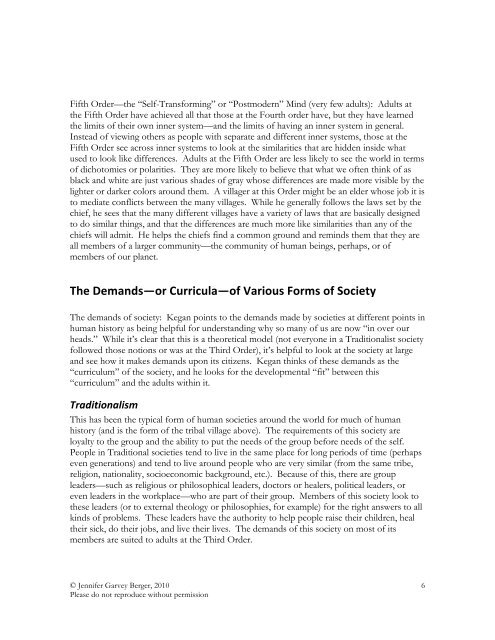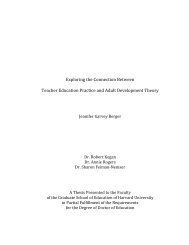Key Concepts for Understanding the Work of Robert Kegan Jennifer ...
Key Concepts for Understanding the Work of Robert Kegan Jennifer ...
Key Concepts for Understanding the Work of Robert Kegan Jennifer ...
You also want an ePaper? Increase the reach of your titles
YUMPU automatically turns print PDFs into web optimized ePapers that Google loves.
Fifth Order—<strong>the</strong> “Self-Trans<strong>for</strong>ming” or “Postmodern” Mind (very few adults): Adults at<strong>the</strong> Fifth Order have achieved all that those at <strong>the</strong> Fourth order have, but <strong>the</strong>y have learned<strong>the</strong> limits <strong>of</strong> <strong>the</strong>ir own inner system—and <strong>the</strong> limits <strong>of</strong> having an inner system in general.Instead <strong>of</strong> viewing o<strong>the</strong>rs as people with separate and different inner systems, those at <strong>the</strong>Fifth Order see across inner systems to look at <strong>the</strong> similarities that are hidden inside whatused to look like differences. Adults at <strong>the</strong> Fifth Order are less likely to see <strong>the</strong> world in terms<strong>of</strong> dichotomies or polarities. They are more likely to believe that what we <strong>of</strong>ten think <strong>of</strong> asblack and white are just various shades <strong>of</strong> gray whose differences are made more visible by <strong>the</strong>lighter or darker colors around <strong>the</strong>m. A villager at this Order might be an elder whose job it isto mediate conflicts between <strong>the</strong> many villages. While he generally follows <strong>the</strong> laws set by <strong>the</strong>chief, he sees that <strong>the</strong> many different villages have a variety <strong>of</strong> laws that are basically designedto do similar things, and that <strong>the</strong> differences are much more like similarities than any <strong>of</strong> <strong>the</strong>chiefs will admit. He helps <strong>the</strong> chiefs find a common ground and reminds <strong>the</strong>m that <strong>the</strong>y areall members <strong>of</strong> a larger community—<strong>the</strong> community <strong>of</strong> human beings, perhaps, or <strong>of</strong>members <strong>of</strong> our planet.The Demands—or Curricula—<strong>of</strong> Various Forms <strong>of</strong> Society The demands <strong>of</strong> society: <strong>Kegan</strong> points to <strong>the</strong> demands made by societies at different points inhuman history as being helpful <strong>for</strong> understanding why so many <strong>of</strong> us are now “in over ourheads.” While it’s clear that this is a <strong>the</strong>oretical model (not everyone in a Traditionalist societyfollowed those notions or was at <strong>the</strong> Third Order), it’s helpful to look at <strong>the</strong> society at largeand see how it makes demands upon its citizens. <strong>Kegan</strong> thinks <strong>of</strong> <strong>the</strong>se demands as <strong>the</strong>“curriculum” <strong>of</strong> <strong>the</strong> society, and he looks <strong>for</strong> <strong>the</strong> developmental “fit” between this“curriculum” and <strong>the</strong> adults within it.Traditionalism This has been <strong>the</strong> typical <strong>for</strong>m <strong>of</strong> human societies around <strong>the</strong> world <strong>for</strong> much <strong>of</strong> humanhistory (and is <strong>the</strong> <strong>for</strong>m <strong>of</strong> <strong>the</strong> tribal village above). The requirements <strong>of</strong> this society areloyalty to <strong>the</strong> group and <strong>the</strong> ability to put <strong>the</strong> needs <strong>of</strong> <strong>the</strong> group be<strong>for</strong>e needs <strong>of</strong> <strong>the</strong> self.People in Traditional societies tend to live in <strong>the</strong> same place <strong>for</strong> long periods <strong>of</strong> time (perhapseven generations) and tend to live around people who are very similar (from <strong>the</strong> same tribe,religion, nationality, socioeconomic background, etc.). Because <strong>of</strong> this, <strong>the</strong>re are groupleaders—such as religious or philosophical leaders, doctors or healers, political leaders, oreven leaders in <strong>the</strong> workplace—who are part <strong>of</strong> <strong>the</strong>ir group. Members <strong>of</strong> this society look to<strong>the</strong>se leaders (or to external <strong>the</strong>ology or philosophies, <strong>for</strong> example) <strong>for</strong> <strong>the</strong> right answers to allkinds <strong>of</strong> problems. These leaders have <strong>the</strong> authority to help people raise <strong>the</strong>ir children, heal<strong>the</strong>ir sick, do <strong>the</strong>ir jobs, and live <strong>the</strong>ir lives. The demands <strong>of</strong> this society on most <strong>of</strong> itsmembers are suited to adults at <strong>the</strong> Third Order.© <strong>Jennifer</strong> Garvey Berger, 2010Please do not reproduce without permission6




